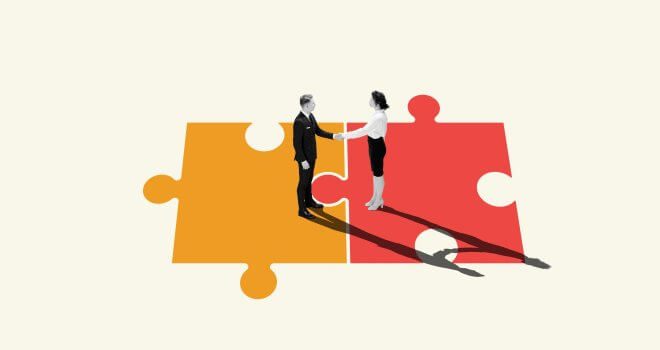Business Resilience Is For Life, Not Just For Lockdown

‘Resilience’: a word used and abused almost as much as ‘innovation’. But over lockdown and the subsequent months, it really came to mean something, on a personal and business level. This got us thinking – how can we define resilience? And if it can be defined, can it be measured (and therefore improved)?
In the early months of the pandemic, Kin + Carta compiled a Brand Resilience Index, defining four key dimensions of resilience (Agility, Maturity, Responsibility and Humanity), and combined over 30 different measurable markers of business resilience to create a scoring methodology.
We ranked 33 British brands – from Tesco to Pip & Nut, Severn Trent to Vodafone – and while the full analysis of findings is published in a 44-page whitepaper, one of the key insights was this: four of the ten brands rated most agile came from the financial services sector.
Not surprising, given these businesses had already weathered and learned lessons from the 2008 financial crash. Their current resilience stems mostly from Agility, and that’s down to more than just a process. It’s a mindset, and a string every business should look to add to its proverbial bow.
Agile is for the whole culture, not just for technology.
Agile practices are often applied in name only. XP, Scrum, Kanban, SAFe, DAD – to name just four of the many practices available – are frequently implemented as a top-down decision. They’re expected to deliver the benefits of Agile, such as responding rapidly to feedback, reducing waste, time to market, by just applying the process alone. But that’s not enough.
On one hand, any organisation or department can ‘do’ Agile simply by following a prescriptive approach, in the same way that anyone can learn to drive a car.
But what makes the key, substantial change is this: the difference that shifts an organisation from simply existing to one that’s a disrupter, a fighter and a survivor, is their ability to culturally, structurally and strategically be agile. Note here the intentional shift from a noun to a verb, from Agile to agile. This subtlety is easily missed and misunderstood, yet it’s the most important ingredient in resilience. In being not just someone who drives a car from A-B, but someone who drives with the car, feels the road – each twist and each turn, knowing exactly when and why to change gears.
As part of our work with RBS, we collaborated across boundaries with stakeholders from various business influences, to understand waste impacting the project. Taking on the agile mindset of ‘inspect, adapt and iterate’, we used value stream mapping to identify and then remove inefficiencies within and around the project, which resulted in cost savings and quicker time to deliver value. This is just one example of how our agile culture and approach helped us to create the multi-award winning app Bankline, bolstering RBS’s credentials and enabling the business to become more resilient to change.
Ensure your employee experience is as well-connected as your customer experience.
Great CX can’t be delivered if employees within your organisation aren’t aligned, connected and communicating effectively across touchpoints. To fully deliver your brand promise, your organisation’s internal processes have to meet external perceptions. I’m sure most of you can identify with the frustration of poor information-sharing between sales and customer support teams!
Businesses that were able to pivot effectively during the pandemic have a clear sense of purpose, which is embraced by every employee (Airbnb is the oft-cited example – moving to a digital experiences model during lockdown). Your people make the wheels turn, so it’s integral they understand what the business stands for and how that brand purpose should affect every single decision, whether that be customer service, financial or design-related.
Technology can ensure information flow is as fast as possible in an organisation – from customers to employees to decision-makers. If feedback can reach decision-makers quickly and visibly, it gives your business the time to act decisively and accurately. If employees feel heard, enabled and empowered, they deliver a better customer experience, creating a win-win for your business.
Why wait to bolster your businesses’ resilience?
So – be agile, embrace your purpose through employees… but what about adverse future events? It’s tempting to simply react, rather than tackle future risks head-on.
Scenario planning is an incredibly powerful tool to help businesses identify potential risks and mitigate them – just because your business has survived (or even thrived) through COVID-19, doesn’t mean you’re prepared for all eventualities.
It’s good business practice to regularly review the landscape of the future – technological innovations, human and societal trends, political situations and the new businesses that emerge – to understand the intersecting forces that could shape your businesses’ future.
Imagining the startup business that would destroy you can lead to the creation of new service lines and revenue streams – adapting proactively rather than reactively.
Resilience isn’t restricted to the big players. Clearly, Tesco’s solid ecommerce platform foundation enabled it to rapidly employ 45,000 new staff in April 2020 to meet the surge of in-home shopping – its digital infrastructure had been accessibly and flexibly built to service the new demand. But we’re also seeing impressive and imaginative pivots at a local, small business level, with pubs and restaurants serving drinks and food to their customers in parks, alongside the burgeoning online fitness sector. Recent research also shows SMEs are more prepared for the coming months – a sure sign of Resilience planning.
‘Resilience’ is more than a buzzword for this pandemic – it’s a way of preparing your business for an ever-changing future. We know that the 2020s will bring seismic political, environmental and social changes – it’s time to bake in the ability to adapt.
Claire Robinson, customer experience director at Kin + Carta Connect; and Ruth-Louise Scholefield, senior agile delivery lead at Kin + Carta Create.




